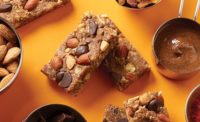Grains are a fundamental ingredient in snack food and bakery products and an important food in consumer diets. In fact, based on the 2020 IFIC Food and Health Survey, consumers view fiber, whole grains, and protein from plants as the healthiest, and most-sought-after, nutrients. The Dietary Guidelines for Americans has long recommended consumers eat between 3 to 8 ounce equivalents per day of total grains based on energy intake, and at least half of the total grains should come from whole-grain sources.
Just recently, the Dietary Guidelines Advisory Committee issued its final report. This report provides the latest scientific information on a broad range of nutrition topics. The information and data contained within this report will help inform and shape the 2020-2025 Dietary Guidelines for Americans, which provide recommendations on healthy eating patterns. The report notes that nearly 75 percent of all Americans exceed the recommendations for refined grains, and 98 percent of Americans consume whole grains at less than the recommended levels. The report also mentions that the sources of whole grains are from a narrow array of foods. These findings create opportunities for new snack and bakery innovations using healthy grains across a broader range of product categories.
Healthy grains
ADM, Chicago, notes that consumers are interested in achieving well-being through a balanced diet and expect products to deliver an enjoyable eating experience in addition to health benefits. “We expect products featuring high-quality protein, satiety benefits, and nutrient fortification to remain on-trend throughout the remainder of 2020 and beyond. Organic grains will continue to trend upward, along with the use of heritage and locally sourced grains, which offer greater supply-chain transparency and a closer connection to the local food movement,” notes Paula Labine, marketing director, milling and starch.
To address the upward organic trend, ADM recently launched a new line of high-quality organic flours, including organic all-purpose flour, organic premium bread flour, organic white rice flour, organic brown rice flour, and organic quinoa flour. The company also offers a wide variety of organic ancient grains and seeds, and organic bean and pulse powders. All of the ingredients are non-GMO.
Riviana, Houston, has also introduced new grain options for the industry. New products from Riviana include Rivland Rice-Gel LCV-350 and Rivland Wild Rice Flour. “Rivland Rice-Gel LCV-350 is a specially processed and precooked extruded rice flour,” says Terry L. Stover, vice president, special markets sales. “It’s extremely bland organoleptically with virtually no noticeable cereal taste. As a pregelatinized rice flour, Rivland Rice-Gel LCV-350 provides excellent thickening properties, even at low temperatures. It can be used as a thickener, binder, or extender and has great freeze/thaw stability. It provides shape-holding and extra crispiness in finished products. Being allergen-free and without taste makes it an excellent component to blend in the recipe.” This ingredient commonly goes into formulas for snack chips and baked goods.
Rivland produces its Wild Rice Flour from wild rice grown in Minnesota. “Wild rice flour provides whole-grain nutrition and is an ideal solution for baked goods, snacks, and cereals. Our Wild Rice Flour has a nutty flavor and is the perfect replacement for nuts in whole-grain applications where nut allergies are a concern.”
Malt Products Corp., Saddle Brook, NJ, recently expanded its OatRite portfolio and launched gluten-free Oat Extract to cater to the growing gluten-free trends. The company has also introduced a Dark Oat extract. These new products are minimally processed, whole-grain sprouted oats, which provide a mild sweetness and pleasant oat taste and aroma, says Amy Targan, president. “Naturally high in protein, minerals, soluble fiber, and antioxidants, the non-GMO extracts offer not only nutritive benefits, but many functional assets, including browning (the Maillard reaction), crystal control for frozen products, improved texture, and extended shelf life.” Product developers can add these new ingredients to formulas for cereal, granola, breakfast bars, pancakes, cookies, and a wide variety of other baked goods.
“More than ever before, consumers have the ability to choose foods that align with their individual values, whether that’s personal health, planetary health, supporting farmers, or enabling an on-the-go lifestyle,” says Don Trouba, senior director, go-to-market, The Annex at Ardent Mills, Denver. “These are all part of what we call ‘Drivers of Innovation,’ and they influence the ingredients we’ve launched over the last year.”
One of the most-exciting and successful introductions has been the Net Carb Application Mix, notes Trouba. Ardent Mills designed the mix for consumers interested in managing their net carb intake. “Net carbs are calculated by subtracting total grams of fiber and sugar alcohols, if present, from total carbohydrates,” he says, noting that attempts at low net carb foods to date have generally lacked craveability and the taste experience consumers expect. “With the Net Carb Application Mix, we’ve solved that,” he says. This new ingredient works well in a range of snack and bakery products, including breads, buns, pizza crusts, and snack crackers.
Trouba is also excited about Colorado Quinoa. “Grown in Colorado’s San Luis Valley, this variety of quinoa compares to many South American varieties, but offers traceability, a U.S.-grown story, and documented water conservation,” he says. “Farmers in our quinoa program are now offered a profitable crop rotation option that promotes soil biodiversity and water conservation. And, because of the relationship with our farmers, our customers know exactly what they are getting and where they are getting it from.” This new ingredient is available in seed, flour, and crisp formats, which work well in crunchy snacks or granola, or as a topping on baked goods.
Brent Galasso, West Coast sales, Brolite Products, Bartlett, IL, notes that the current trends related to grains fall into the “better-for you” category, and reiterates the importance of delivering great taste and eye appeal along, with the better-for-you benefits. The company recently launched a couple of new products that deliver both taste and nutrition. Brolite’s new Low Carb Grain is a keto-friendly full mix, so the grains are already incorporated. Low Carb Grain is made with sunflower and flax seed. Galasso notes this product has performed well in the marketplace.
Brolite has also introduced Malty Grains, which can go into any current grain formulation. “The uniqueness of the product comes from the flavor notes of the various malts that complement the grains,” notes Galasso. Malty Grains is available in a range of granulation sizes.
While these new ingredients from Brolite are best suited for yeast-raised breads, grains can be used in any baked good—although the granulation size may need to be adjusted depending upon the application. The company also has the capability to develop custom grain blends based on the specific needs and application of the customer.
Grain Millers Inc., Eden Prairie, MN, has introduced three new fiber ingredients that can further enhance whole-grain products and address potential texture or product characteristic challenges that might arise when transitioning from conventional baked goods to whole-grain or gluten-free, notes Rajen Mehta, PhD., senior director, specialty ingredients:
- BCS30-SL-B: a long and soft oat fiber powder that is effective in reducing breakage in snacks and cracking in tortillas, can improve the resiliency in breads, and can help control the shape and add a chewy character to bars
- BCS30FL – C: a long and firm oat fiber powder that can add crispness to snacks, such as adding rigidity and a crispy, firm bite if a bar product is too soft
- BCS30SL-B + BCS42 (75/25 ratio): another oat fiber combination that, when used as a blend, allows particulates to stick to snacks and baked goods while concurrently reducing breakage in snacks and increasing volume
Ancient interest
Several companies have seen increased demand for ancient grains, crops that have largely been untouched by modern science or breeding technologies over the last several hundred years. Typically, ancient grains are a rich source of nutrients such as protein, fiber, vitamins, and minerals and can have distinctive, flavorful taste profiles.
EverGrain Ingredients, St. Louis, is on a mission to create sustainable, nutritious, and functional food ingredients using barley, one of nature’s ancient grains. “Barley is a versatile, nutrient-rich grain whose usage has traditionally been limited to bread and beer,” says Charlie Ross, chief business officer. “Using our innovative processes, we are realizing and capturing the full potential of barley with the launch of our new protein and fiber-rich ingredients: EverVita Fibra and EverVita Pro.
EverVita is produced from high-quality malted barley (it has gone through a sprouting process) and has had the starch gently removed, notes Ross. “EverGrain’s development process maintains everything exceptional that is inherent in barley and elevates the nutritional profile around fibers and protein. EverVita Fibra is a high-fiber (60 percent) product that can be easily integrated into any flour blend and labeled as ‘barley flour.’ EverVita Pro, in addition to fiber, has a higher protein content (35 percent) and can thus be labeled as ‘barley fiber’ and ‘protein.’”
Ross provides a few examples of how these new barley ingredients can benefit snack and bakery products:
- Cookies and crackers: provides an appetizing golden-brown color; promotes crispness and crunchiness with a light texture
- Bars and snacks: has a clean taste with desired texture and chew and minimal moisture transfer; promotes a crisp and crunchy texture for extruded snacks, while enabling positioning as a higher-protein and/or higher-fiber product
- Cakes and muffins: higher specific volume than cakes fortified with wheat bran or whole-meal flour; water-binding properties to retain moisture during baking; lower in carbohydrates and calories
EverGrain Ingredients is beginning to work with potential customers, and these new products will be commercially available on the market by the fourth quarter of 2020.
Snack producers and bakers can achieve a cumulative effect via grain ingredient additions. “Product developers can differentiate snacks and baked goods by pairing standard whole grains with emerging, interesting ingredients such as chia, hemp seeds, millet, and sorghum,” says Labine. “Consumers are more willing to take a chance on offerings with unfamiliar ingredients when paired with traditional grain ingredients in familiar formats.”
According to proprietary ADM OutsideVoice research conducted in 2019, hemp is a more-mainstream ancient grain with 26 percent awareness. Its awareness levels are similar to buckwheat (27 percent) and millet (25 percent). It ranks behind quinoa (66 percent) but ahead of other lesser-known ancient grains such as amaranth (16 percent) and spelt (15 percent). ADM recently introduced on-trend hemp hearts (hulled hemp) and hemp powders (50 percent and 33 percent protein levels), which deliver nutritional benefits, such as plant-based protein, omega-3 and omega-6 fatty acids, and fiber.
“Hemp hearts add texture and whole-food benefits to snack and baked good applications like crackers, bars, breads, and muffins. Hemp powders can be used at levels similar to protein powder, adding a nutritional boost to breads, crackers, and cereals, particularly in gluten-free applications,” says Labine. Both of ADM’s new hemp products are non-GMO.
Healthy Food Ingredients (HFI), Fargo, ND, has continued to focus new opportunities on its heritage grains, such as spelt. “Interest in using spelt in multiple applications continues to grow. The greatest number of product launches we have seen is in bread and baked goods, but there are even chocolate confectionary items on the market that use puffed spelt. Spelt offers the benefits of being an ‘ancient grain,’ yet is more cost-effective than some of the alternatives in that category,” notes Joni Huffman, senior vice president of sales and marketing. Healthy Food Ingredients offers spelt in a number of different formats, including spelt flour, whole berries, and flakes.
Huffman also notes that HFI is working with snack customers using blue emmer. “Blue emmer is a wheat variety that, true to its name, has a grayish-blue shade and is quite unique in flavor and appearance. It makes a wonderful artisan whole-grain bread and can be used in crackers or multigrain products.” Both of these ingredients are whole grains, which contributes significantly to multiple health benefits, such as gut and heart health.
Organic farmer Bob Quinn, Ph.D., founder, KAMUT International, Missoula, MT, notes an increasing demand for ancient grains like KAMUT brand khorasan wheat, spelt, farro, emmer, and eikhorn due to their nutrition and health benefits. KAMUT brand khorasan wheat is an ancient grain that has never been hybridized or genetically modified and is always organically grown on certified-organic farms located primarily in the Northern Great Plains of North America.
In addition to its nutritional contributions, khorasan wheat offers good flavor. “The natural sweetness and nutty butter flavor of KAMUT wheat is an additional factor that makes this ancient grain the perfect ingredient for cereals, cakes, pastry, and bread,” notes Quinn.
With consumers snacking with greater frequency, Quinn saw an opportunity to develop Kracklin’ KAMUT brand ancient-grain snacks. The product contains only three ingredients, including KAMUT khorasan wheat. The company originally created a Sea Salt variety but has recently added another variety to the line, a churro flavor.
Trevor Blyth, CEO, KAMUT International, shares the features of this new product:
- Made with simple and clean ingredients—no artificial flavors or colors
- Made from organic KAMUT brand wheat grown in Montana
- Contains no cholesterol or trans fat, nut-free, and vegan-friendly
- An excellent source of protein, fiber, zinc, magnesium, vitamin B1, and vitamin B3, and contain a high level of carotenoids and a diverse profile of polyphenols
Nu Life Market, Scott City, KS, notes that sorghum is a go-to cereal grain for new and innovative snack and bakery products. Sorghum meets the growing consumer demand for clean-label, healthy, allergen-free, and non-GMO ingredients, notes Earl Roemer, founder and president. Sorghum also contributes to the health and sustainability of the environment. “The low carbon footprint and lower use of natural resources in the production of sorghum grain has placed even more emphasis on the utilization of this cereal grain because of its environmental and food security benefits.”
Nu Life Market recently launched FibraGel Sorghum Flour, made from waxy burgundy sorghum, a new variety developed by the company’s plant breeding program a few years ago. “FibraGel Sorghum Flour provides the nutrition of whole-grain sorghum flour, but with increased functionality,” says Roemer. “It is created using a proprietary process that conditions the starches to provide ideal binding characteristics in many applications. It increases volume in gluten-free and vegan baked goods, improves the shelf life of gluten-free formulas, makes baked goods more moist and tender, improves product volume, increases dough elasticity, and improves crumb structure.”
Another new option is the NutraEZ line. “Produced using exclusive extrusion technology, the NutraEZ product line includes whole pulses and whole-grain ingredients with controlled starch functionality and enhanced nutritional protein digestibility,” says Roemer. “The NutraEZ products provide excellent binding and gelling characteristics, as well as a way to introduce whole grains and pulses to extruded and sheets snacks.” The new NutraEZ products are available in pellet or flour formats.







